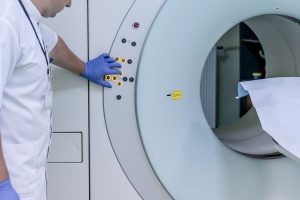
Medical careers are often referred to as recession-proof, as there seems to be an endless supply of patients.
Doctors and nurses will always find a use for their specialties.
Additionally, there is a growing demand for all the medical specialists who work alongside the doctors and nurses.
These technicians and medical machine operators are at the forefront of the new and emerging technology.
Technology has helped make diagnoses and treatments increasingly more advanced and accurate.
MRI Technologists, for instance, help to provide views of patients which were only available through surgery in the not-so-distant past.
Could an MRI Technologist be the right career move for you?
Page Navigation
- What Courses Are in an Online MRI Technologist Program?
- Can You Earn an Online MRI Technologist Certification Completely Online?
- How Long Does it Take to Earn an MRI Technologist Certification Certification Online?
- How Much Does an Online MRI Technologist Certification Certification Cost?
- Benefits of Online MRI Technologist Training Programs
- Drawbacks of Online MRI Technologist Training Programs
- Benefits and Drawbacks of Online MRI Technologist Training Programs – Summary Table
- Types of MRI Technologist Certifications
- 4 Self-Study Tips for MRI Technologist Online Students
- Next Steps
- Frequently Asked Questions
What Courses Are in an Online MRI Technologist Program?
MRI, which stands for magnetic resonance imaging, is a method of scanning and developing images of a patient’s internal body structure.
MRIs use radio waves to image patients.
Along with x-rays and CAT scans, MRIs have helped medicine move beyond strictly needing surgery to diagnose patient ailments.
As an MRI technologist, you will need to know how to operate and service the equipment, as well as manage patients.
A calm bedside manner is necessary for many patients to relax during the MRI procedure.
It is also necessary to develop a cursory understanding of the various medical conditions which you will be scanning for.
Some of the classes and courses you will need to complete include:
- Chemistry
- Human Biology
- Anatomy
- Physiology
- Microbiology
- Managing and recording patient vital signs
- Sonographic Principles and Instrumentation
- Radiology Physics
- Customer service
- Intermediary computer literacy
- Clinical Radiology studies
- Magnetic Resonance
- Radiographic Positioning
In addition to the specific courses designed for MRI training, students will also need to have completed an Associates of Arts or Associates of Science two-year degree.
Can You Earn an Online MRI Technologist Certification Completely Online?
Yes, it is possible to complete your MRI coursework entirely online, depending on the school.
You will need an Associate’s Degree before beginning your MRI coursework.
Most Associate’s Degrees are two-year programs.
Some schools do require additional in-person clinical training.
MRI Technologists will also want to obtain certification to ensure greater job opportunities and rate of pay.
How Long Does it Take to Earn an MRI Technologist Certification Certification Online?
MRI certification is accomplished through the American Registry of Radiologic Technologists (ARRT).
Applicants will need to complete a 1-2 year MRI training program through an accredited school before applying for certification.
You are then allowed three attempts within three years to pass the required MRI exam.
How Much Does an Online MRI Technologist Certification Certification Cost?
Depending on the program and school/institution, the average in-state tuition cost will be $5,000.
Out-of-state tuitions average around $18,000.
Partial scholarships and grants are available for qualified applicants.
Most schools also offer tuition reimbursement programs.
Benefits of Online MRI Technologist Training Programs
1. Learn while you work
Many online students are balancing an existing work schedule with their coursework.
Completing online coursework allows for flexible scheduling for both work and school.
Students can also attend classes from various locations.
Not being tied to a classroom location can allow more students to pursue their higher education goals.
2. More one-on-one instructions
When completing coursework online, your communications will tend to be structured around online messaging and e-mail.
While, on the one hand, this may seem more isolated, there is also a natural channel of communication that grows around the class.
Reaching out to an instructor can be more specific.
More detailed.
Compose your thoughts and create questions as you study that can later become emails and chat messages.
Your instructor will also appreciate the input, as they need to know what the class knows and is absorbing.
3. The ability to access online help
Working in an online environment offers students the tools of the internet.
If you have questions or need further explanation, it is almost a certainty that there is a blog post or video which references your very question.
Of course, in-person classes are able to tap into the same resources.
With an online format, the instructor(s) often build the instruction around the use of online tools.
4. Affordable and convenient
By giving students financially viable options for gaining certification, more students can become technicians without breaking the bank.
Affordable online courses also offer students convenient methods for increasing their overall educational goals.
Advanced education equals greater skills as a technician, too, which can also increase earnings.
As students become more educated, they become more valuable to their employees and their patients.
Drawbacks of Online MRI Technologist Training Programs
1. Lack of hands-on instruction and practice
When completing courses online, especially in the medical field, it is important to be able to put the learning into practice.
What is read and observed also needs to be manually done.
The bridging of the theoretical with the actual helps to solidify knowledge.
It is also critical to see an expert perform certain procedures.
Watching someone with experience do your future job can greatly assist in clarifying some hows and where’s.
It can also help create your personal MRI technique.
2. Fewer peer interactions
Sometimes, the learning is best facilitated by student comments and class discussions.
Although commenting and chat-posting can occur in real-time for an online class, it is not the same as the interaction in a live classroom.
For online students, it may be necessary to link up with other online cohorts to get a bit of the interaction happening.
At the very least, camaraderie can help drive motivation to do well and complete the course.
3. Students need to be motivated and conscientious learners
It is easy to get distracted when you are working or studying from home.
As a student, it can be tempting to put off your studies for another day.
After all, is the teacher even paying attention? (They are;)
The best online students understand that you have to discipline yourself from the very beginning.
Make study schedules and stick to them.
Practice for tests often and make sure you always read the material provided.
4. Longer hours of independent study
Since you will be completing training from home or a non-classroom location, you will find you are responsible for more of the studying and reviewing for tests.
Traditionally, when students are left to study on their own, versus completing study exercises in a classroom setting, the latter garners the better scores.
If possible, connect with other students who are studying online.
Try to organize online study groups to help each other become more knowledgeable and prepared.
Benefits and Drawbacks of Online MRI Technologist Training Programs – Summary Table
| Benefits of Online MRI Technologist Training Programs | Drawbacks of Online MRI Technologist Training Programs |
|---|---|
| Learn while you work | Lack of hands-on instruction and practice |
| More one-on-one instructions | Fewer peer interactions |
| The ability to access online help | Students need to be motivated and conscientious learners |
| Affordable and convenient | Longer hours of independent study |
Types of MRI Technologist Certifications
Certifications for MRI Technologists are usually offered through two national organizations:
- American Registry of Radiologic Technologists (ARRT)
- American Registry of Magnetic Resonance Imaging Technologists (ARMRIT).
ARRT-
- Applicants are examined through both written and practical components to determine competency.
- Certification must be renewed annually.
- Applicants must have completed 24 hours of continuing education within two years of re-applying.
ARMRIT-
- Applicants are required to demonstrate their educational and clinical experience and expertise.
- Re-certification is required every three years.
- Applicants must have completed 24 hours of continuing education in their last three years.
- There is also a $300 re-certification fee.
- Applicants must notify ARMRIT if they have been convicted of a felony.
4 Self-Study Tips for MRI Technologist Online Students
1. Study frequently and often.
You are working and studying to start a career in healthcare.
You need to not only know the information backward and forwards but become so confident in the info and terminology that you are at ease treating patients.
By regularly studying in small bursts, you avoid burn-out from overexposure or marathon study sessions.
You will also become comfortable speaking the language of an MRI technician, which will help streamline your move into a career.
2. Develop study partners or study groups
One of the keys to effective classrooms is student interaction.
Even if just in the form of class discussions, the sharing of ideas and questions helps to clarify information for so many.
With online classes, the classroom effect can be lost.
There are still discussions in the classroom chat areas, but some students will benefit more by connecting with other students in groups outside of class.
In these forums, students are more likely to open up and ask real questions.
Studying is also improved when classmates can ask each other questions and really probe what is understood before the exams take place.
3. Take lots of notes
Get in the habit of writing down as much information as you can while class is taking place.
Include your questions and even the good questions of others.
Drawing sketches can even be appropriate when examining equipment.
Then, when you have time soon after class, re-write and clarify all of the notes you took.
Make sure you understand what you wrote and why it was important.
Write down the explanations, too.
As you go through the class, you will start to organize your notes better during class.
Then, at the end of the course, you will have a study guide for the exam.
4. Create a positive, non-distracting work environment
Some students will swear by multi-tasking.
If you have headphones in, the TV playing, while chatting online during study time, you’re not multi-tasking.
You are just dividing your brain’s time.
You are also processing and retaining less information.
Try to find or create a quiet place in which you detach from other interests and just focus on your studies.
If you have roommates, you might have to make some concessions.
Library or coffee shop visits may be a good trade-off for finding quiet spaces.
Next Steps
Becoming an MRI technologist can offer individuals of various backgrounds the possibility to enter the medical field.
Once employed, opportunities for advancement and additional training will quickly present themselves.
Consider which work and school schedule will meet your needs the best before searching for the school you will apply to.
Make sure you will have ample time to focus on your studies.
Then, as you are working towards certification, make sure you are reaching out to potential employers to see what they’re looking for in an employee.
Frequently Asked Questions
What is the earning potential for a licensed and certified MRI Technologist?
MRI Technologists average around $75,000 throughout the US.
The low range for salary is around $62,000 and the top end is beyond $85,000.
Most salary fluctuations are affected by the location in the US in which the technologist works and the competitiveness of the industry in that area.
Is there a market for MRI Therapists in the US?
There is a projected growth of nearly 10% for the next ten years for MRI and radiology techs.
Various job markets with greater potential for growth will be more favorable to employment opportunities.
MRI technologists can also find some employment opportunities within private practices and military fields, as well.
Are there risks associated with becoming a MRI Technologist?
Since MRIs require high levels of radio and magnetic waves, there is a risk of overexposure and potential health consequences.
At the same time, there are numerous safety procedures in place to help patients and technologists to remain safe.
With a background in MRI technology, trainees can also pursue careers as Diagnostic Medical Stenographers, Radiation Therapists, or Nuclear Medicine Technologists.
Additionally, working in the medical field opens up opportunities for all kinds of different medically-related occupations.
Networking and communication are key to maximizing your opportunities.






